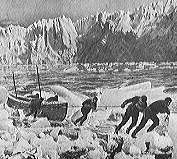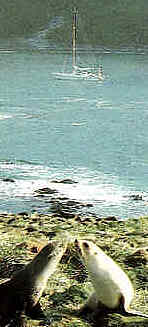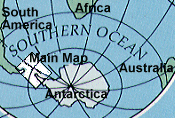
![]()
.
.
.
.

.
.
.
.
.
.
.
.
.
.
.
.
.
.
.

.
.
.
.
.
.
.

![]()

[
Logbook Index ]

Log
Entry for 8 February 1997
Click map for detailed chart
Position 1200 54 00S 38 00W Bird Sound. Wind NW
25 knots. Barometer 1004mb.Visibility nil.
South Aris team lay a plaque at Shackleton's first landing place and Pelagic makes her way to the head of King Haakon Bay to drop off climbing party for their traverse of South Georgia.
|
Antarctic Bay is the most likely place the South-Aris team will drop into, if they run into difficulties while on the traverse. Twelve miles westward of Leith Harbour, Antarctic Bay is another fjord like feature, unsurveyed, very wide and four miles long. The head of the bay is a glacier ice front with seracs continually 'calving off' into the sea below. On the 7th February, as soon as we dropped anchor in 10 meters alongside the beach, we saw a huge block come away and seconds later heard the loud heavy artillery report of the ice cracking. About a minute later, the wave created by this 'calving' set Pelagic to a gentle roll while on the beach a sizable surf came ashore - big enough to swamp a dinghy if caught unawares. This area of calving ice was the first obstacle the climbers had to negotiate whilst laying a small depot as an emergency cache and reconnoitring the Shackleton traverse. After many difficulties climbing through a section of the icefall and then a pitch of slippery rock, Frank, Paddy and Mike finally disapperared from our view as they arrived onto the easier ground of the Crean Glacier. (Named after Tom Crean who accompanied Shackleton and Worsely on the traverse). Four hours later they returned and were plucked off the beach. They reported that the section to the next col overlooking the Fortuna Glacier (to the east) was heavily crevassed and looked like slow going. The cache was laid successfully alongside an obvious feature in the moraine and was marked by a red flag and pole. Frank was all for pushing right around to King Haakon Bay, but it was still blowing northwest 25 to 30 knots, so to save ourselves an unpleasant night we ducked into Prince Olaf Harbour after only seven miles. There we lay to an old jetty with another abandoned whaling station as a backdrop. A late dinner, a short sleep and five hours later we were at sea again at first light, 0500. The wind was down and the going easier. By 1200 on 8th February, we were passing through Bird Sound, a very narrow passage between the northern tip of the mainland and Bird Island. This outlying island is a mile long, tussock covered and home to thousands of seabirds including the great wandering albatross. There is also a macaroni rookery with 80,000 breeding pairs. Of course the fur seals are dominant and although the visibility was almost nil, we could hear their barking, whining and braying through the mists. Bird Island is officially a restricted area because it is designated as a Site of Special Scientific Interest. Three British Antarctic Survey field biologists are normally in residence. As we passed unseen in front of their cove, we called them on the radio and and gave them our itinerary, hoping to be able to at least anchor in the bay as our first stop on our return journey. . King Haakon was only 20 miles to the southeast, so we pushed through quickly, sailing fast in the fresh northwester. By 1700 we were near the uncharted entrance and the big breakers on the reefs which litter the approach were easily discernable in the heavy westerly swell - a paradox as in calm conditions they would be less apparent and therefore more menacing! Job number one in King Haakon was to land at Cave Cove somewhere near the southern headland of the fjord in order to find Cave Camp. We had aerial photographs of the cape, "South" by Shackleton and "Shackletons Boat Journey" by Worsely. These principal texts were produced and read aloud on deck, as Pelagic heaved up and down in the confused swell. After some discussion while motoring to and fro, we launched the dinghy and the first group went ashore. They were armed with hammer, bolt drill and spanner to attach a bronze plaque commemorating Shackleton's first landing on South Georgia after the boat journey. The South-Aris team had carried this plaque on the Tom Crean, luckily salvaging it during the rescue. This moment must have been hard for the crew as they should have been arriving not on Pelagic, but in the fashion of Shackleton and his men in 1916. In "South" Shackleton says, "A small cove, with a boulder strewn beach guarded by a reef, made a break in the cliffs on the south side of the bay, and we turned in that direction. I stood up in the bows directing the steering as we ran through the kelp and made the passage of the reef. the entrance was so narrow that we had to take in the oars . . . . but in a minute or two we were inside. . . . and the James Caird ran in on a swell and touched the beach." The cove is indeed a life saver, totally wind protected with an easy slope of tussock leading up to some fresh water lakes. The cave alongside the eastern wall where they huddled together and spent the first night bore no evidence of this grand adventure of survival, but its crude austerity was inspiration enough. The South-Aris team bolted their plaque onto an outcrop of schist, two meters above high water . It reads: On the 10th of May 1916 Sir Ernest Shackleton landed at Cave Camp after his journey from Elephant Island in the open boat James Caird. His five companions were Frank Worsely, Tom Crean, Tim McCarthy, Harry McNeish, J. Vincent "Sir Ernest Shackleton's name will for evermore be engraved with letters of fire in the history of Antarctic exploration" Roald Amundsen Erected in February 1997 by the Irish South-Aris Antarctic Expedition The job done, we upped Pelagic's anchor and sailed east down the 7 miles of King Haakon Bay. In the fading light we dropped the hook in 14 meters behind the Vincent Islands, the bay's only protection for small craft. We were now at the fourth of the historical landings in this story, Shackleton's 'Peggoty Camp,' where he sailed the day after arriving at Cave Camp. Here he made preparations for the crossing of South Georgia. If the weather holds fine tomorrow the the Irish will be following in his footsteps. Skip Novak |

